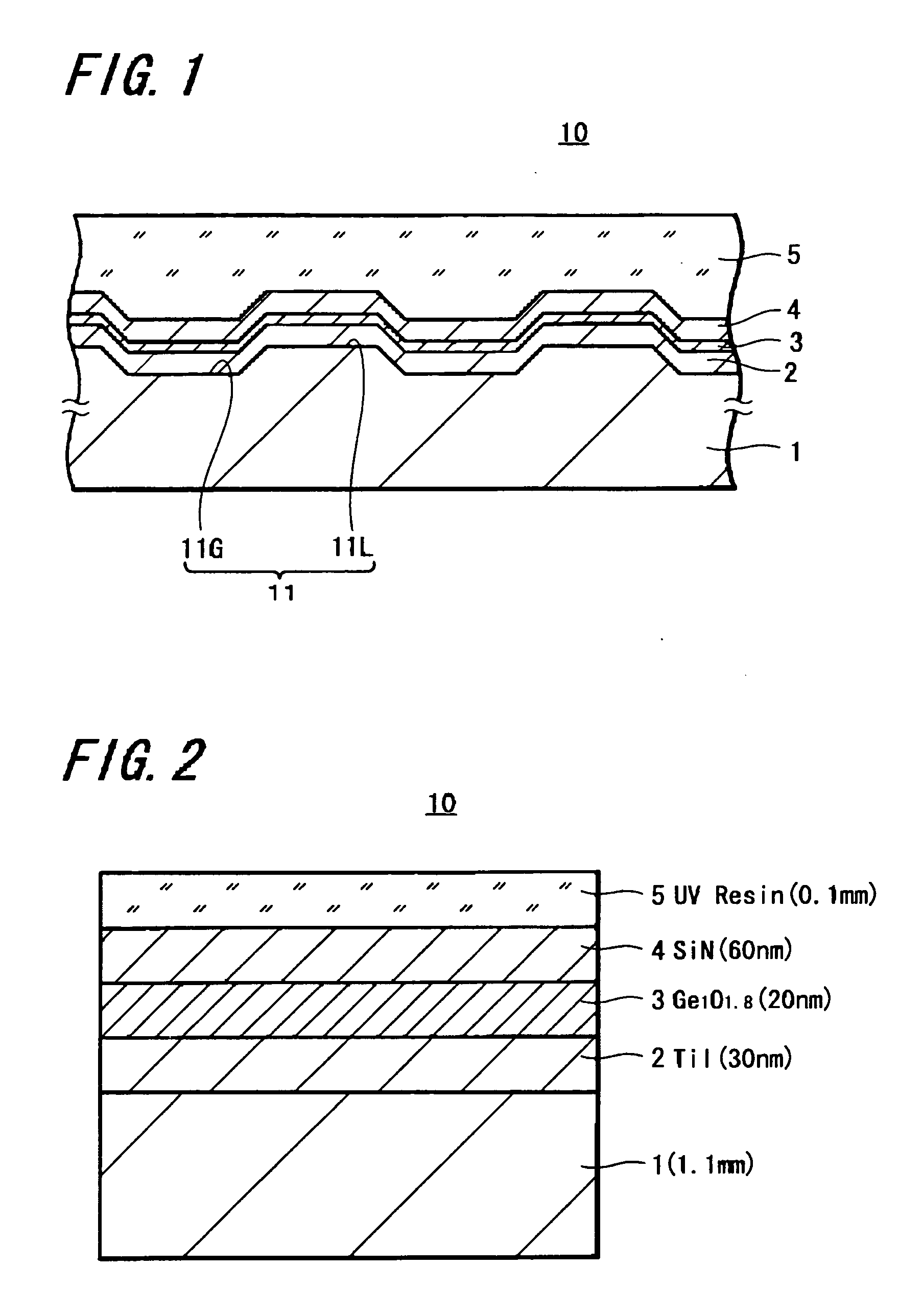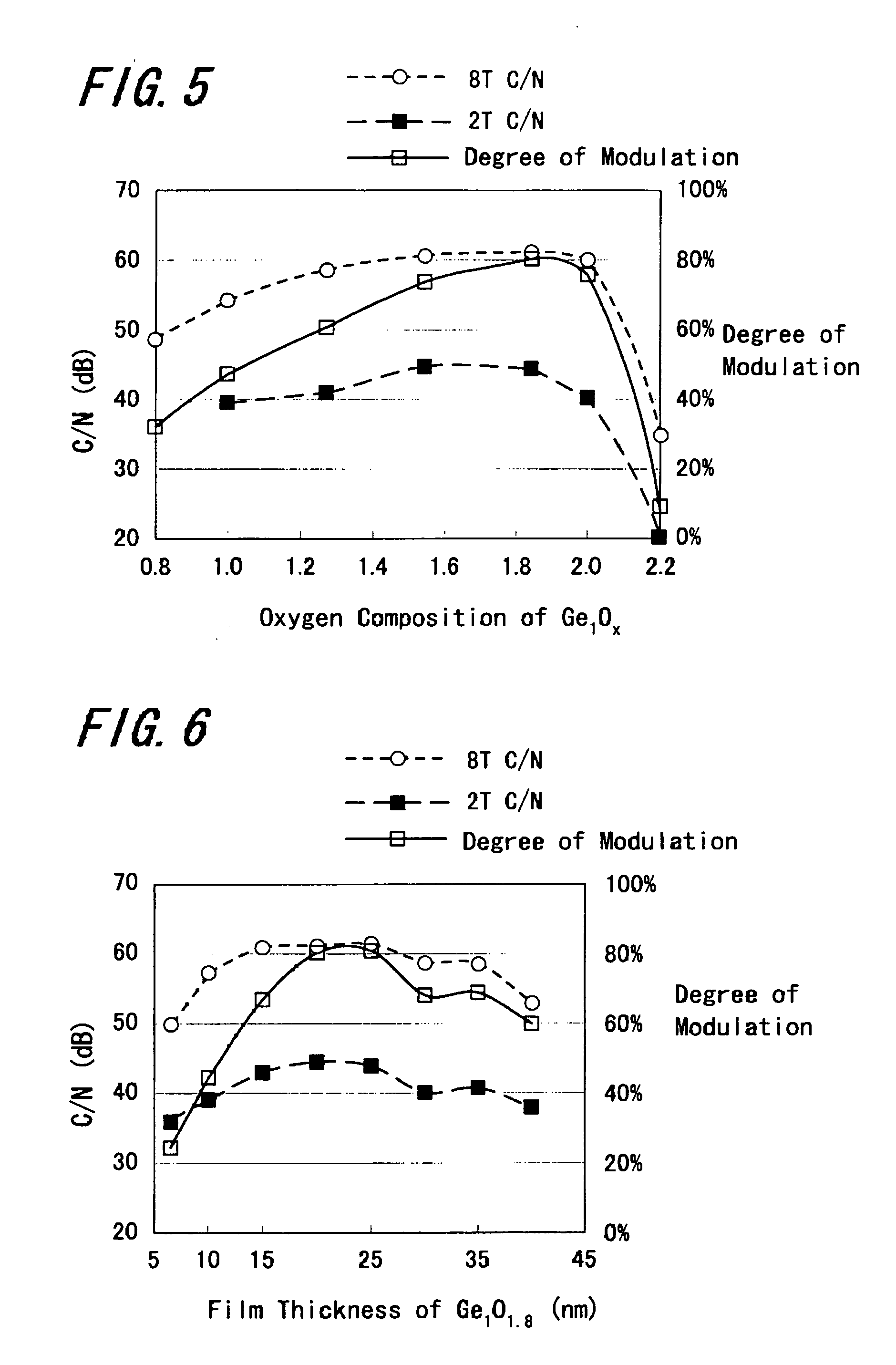Write once optical recording medium
a recording medium and optical recording technology, applied in the field of write once optical recording medium, can solve the problems of inability to make the inorganic recording medium compatible with the rom, inability to read only memory, and inability to reduce the size of dye molecule, etc., to achieve excellent recording and reproducing characteristics
- Summary
- Abstract
- Description
- Claims
- Application Information
AI Technical Summary
Benefits of technology
Problems solved by technology
Method used
Image
Examples
##ventive example 1
INVENTIVE EXAMPLE 1
[0056] This inventive example 1 is an inventive example corresponding to a Blu-ray Disc (hereinafter simply referred to as a “BD”) which can be recorded and reproduced by an optical disc recording and reproducing apparatus including a violet semiconductor laser light source having a wavelength of 405 nm through a two-group objective lens with a numerical aperture (N.A.) of 0.85.
[0057]FIG. 2 is a schematic cross-sectional view of a film arrangement showing an arrangement of the write once optical recording medium 10 according to this inventive example 1 from which the concave and convex surface is omitted.
[0058] A film deposition system for manufacturing this write once optical recording medium 10 was a film deposition system manufactured by UNAXIS JAPAN CO., LTD., under the trade name of “Cube”. A target size used at that time is a diameter φ of 200 mm.
[0059] The substrate 1 may have an arrangement in which the above-mentioned concave and convex surface 11 form...
##ventive example 2
INVENTIVE EXAMPLE 2
[0082]FIG. 3 is a schematic cross-sectional view of a film arrangement showing an arrangement of a write once optical recording medium according to an inventive example 2. As shown in FIG. 3, in this inventive example 2, Al was used as the metal film 2 and a film thickness of SiN of the dielectric film 4 was selected to be 20 nm. Other film deposition conditions and evaluation methods were selected to be the same as those of the inventive example 1.
[0083] In this case, the reason that the film thickness of the dielectric film 4 is thinner than that of the inventive example 1 is based on an optical reason. That is, since Al used as the metal film 2 remarkably differs from Ti in optical constant, effect of multiple beam interference caused by SiN is different and hence desired reflectance can be obtained by optimizing the film thickness of the SiN film.
[0084] According to the write once optical recording medium 10 of this inventive example 2, after information was...
##ventive example 3
INVENTIVE EXAMPLE 3
[0088] This inventive example 3 is the case in which an alloy of Al and rare earth metal Gd, that is, AlGd is used as the metal film 2 and a rest of arrangements is similar to that of the inventive example 2. In this inventive example 3, the composition of AlGd, that is, Al:Gd (atomicity ratio) was approximately selected to be 7:3 by the atomic number ratio. FIG. 4 is a schematic cross-sectional view of a film arrangement showing an arrangement of a write once optical recording medium 10 according to this inventive example 3.
[0089] While rare earth metals are materials which can easily be oxidized and they are low in thermal conductivity, it is possible to adjust recording sensitivity by alloying rare earth metals with Al.
[0090] While Tb, Dy and Nd can be used as the rare earth metals in addition to Gd, characteristics of these rare earth metals Tb, Dy and Nd are very similar to each other and hence this inventive example 3 can demonstrate nearly the same charac...
PUM
| Property | Measurement | Unit |
|---|---|---|
| thickness | aaaaa | aaaaa |
| thickness | aaaaa | aaaaa |
| wavelength | aaaaa | aaaaa |
Abstract
Description
Claims
Application Information
 Login to View More
Login to View More - R&D
- Intellectual Property
- Life Sciences
- Materials
- Tech Scout
- Unparalleled Data Quality
- Higher Quality Content
- 60% Fewer Hallucinations
Browse by: Latest US Patents, China's latest patents, Technical Efficacy Thesaurus, Application Domain, Technology Topic, Popular Technical Reports.
© 2025 PatSnap. All rights reserved.Legal|Privacy policy|Modern Slavery Act Transparency Statement|Sitemap|About US| Contact US: help@patsnap.com



